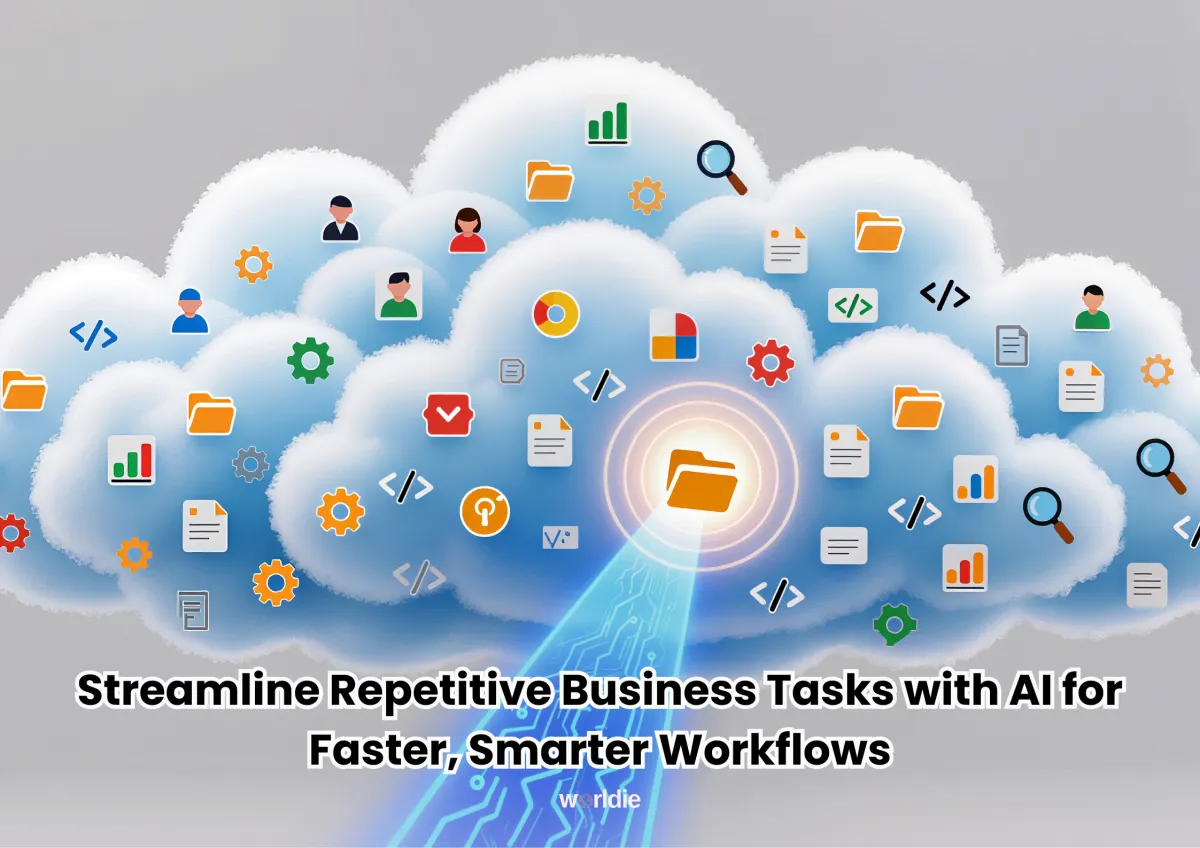
Streamline Repetitive Business Tasks with AI for Faster, Smarter Workflows
Using AI to streamline repetitive business tasks is more than a technological upgrade—it is a strategic lever for businesses seeking to accelerate growth, improve efficiency, and transform revenue generation. Repetitive tasks, while essential for daily operations, often consume excessive time, introduce errors, and limit teams from focusing on high-value initiatives. AI-powered automation allows organizations to handle these tasks intelligently, ensuring operational precision and freeing human resources for decision-making, innovation, and customer engagement.
In this article, we explore how AI can revolutionize business workflows, provide actionable strategies for implementation, and demonstrate how Worldie AI designs, builds, and deploys systems that maximize operational impact.
Understanding AI-Driven Workflow Automation
What “Using AI to Streamline Repetitive Business Tasks” Really Means
AI workflow automation involves using intelligent systems to perform tasks traditionally carried out by humans. These tasks are often repetitive, structured, and rule-based. Examples include entering data into spreadsheets, processing invoices, responding to standard customer inquiries, and generating regular reports. By automating these processes, businesses reduce errors, accelerate completion times, and unlock the potential of human teams for more strategic work.
Artificial intelligence enables these systems to learn patterns, predict outcomes, and even make decisions in complex scenarios. This level of sophistication differentiates simple robotic process automation from AI-driven workflows that adapt, optimize, and scale alongside business growth.
Why Repetitive Tasks Drain Businesses
Repetitive tasks create significant operational friction. They consume time that could be dedicated to strategic projects, introduce errors that result in additional verification or correction work, and slow decision-making because data remains unprocessed or siloed. Furthermore, employees often experience frustration when their work primarily involves low-value activities, impacting morale and retention. By intelligently automating these tasks, AI not only addresses inefficiencies but enhances overall workforce productivity and satisfaction.
Common Inefficiencies in Modern Businesses
Organizations across industries struggle with recurring inefficiencies that hinder growth. Administrative bottlenecks often arise from manual document processing, HR onboarding, and scheduling approvals, slowing operations. Operational inefficiencies are evident in inventory tracking, supply chain management, and customer service routing. Sales and marketing teams face friction when lead qualification, CRM updates, and personalized outreach require repetitive effort.
Addressing these inefficiencies with AI ensures businesses can operate faster, more accurately, and with reduced dependency on manual intervention.
How AI Transforms Industries
Financial Services
Banks and fintech companies process vast volumes of transactions and face stringent regulatory requirements. AI can automate Know Your Customer (KYC) verification, detect fraudulent activity in real-time, and generate compliance reports automatically. These applications reduce human error, improve regulatory compliance, and allow teams to focus on risk management and strategic initiatives.
E-Commerce and Retail
Retail businesses face constant operational and customer service demands. AI streamlines order processing, manages inventory dynamically, and enables personalized marketing at scale. Chatbots, AI-driven recommendation engines, and automated inventory forecasting reduce operational friction while enhancing customer satisfaction.
Manufacturing and Supply Chain
Manufacturers and logistics operators benefit from AI through predictive maintenance, quality control automation, and logistics optimization. AI analyzes sensor data to predict machine failures before they occur, ensures products meet strict quality standards, and identifies the most efficient routes for supply delivery. This proactive approach reduces downtime and minimizes waste.
Healthcare
In healthcare, repetitive administrative work is a major bottleneck. AI can automate patient scheduling, digitize medical records, and assist in diagnostic processes that involve repetitive image or data analysis. These improvements reduce administrative costs, accelerate patient care, and improve outcomes without overburdening staff.
B2B SaaS
Software companies leverage AI to streamline client onboarding, automate support ticket triage, and optimize internal workflows. Intelligent systems can monitor customer behavior, predict churn, and facilitate personalized outreach—all while reducing the repetitive workload on customer success teams.
The Worldie AI Approach: Design, Build, Release
Worldie AI takes a strategic approach to AI deployment, ensuring that automation projects deliver real business value.
Design: Mapping Workflows and Identifying Opportunities
Every AI project begins with a comprehensive understanding of business processes. Worldie AI works closely with clients to map existing workflows, identify high-impact repetitive tasks, and assess data quality and availability. This stage ensures the AI system is purpose-built to integrate with current operations, aligning automation goals with business objectives.
Build: Engineering Scalable and Intelligent Systems
Building AI solutions involves selecting models tailored to the tasks at hand. Natural language processing can automate customer interactions, computer vision can streamline quality checks, and predictive analytics can optimize forecasting. Integration with existing platforms ensures seamless workflow automation. Worldie AI focuses on creating systems that are robust, maintainable, and capable of scaling as business demands grow.
Release: Deployment and Continuous Optimization
Deployment marks the transition from development to real-world impact. Worldie AI emphasizes monitoring, iterative improvements, and performance tracking. By evaluating AI outputs against key performance metrics, teams can ensure the system continues to deliver efficiency, accuracy, and cost savings over time. This approach balances automation with human oversight, creating reliable, long-term operational improvements.
Challenges in AI Deployment
Deploying AI to automate business tasks is transformative but not without challenges.
Data quality is fundamental. Poorly structured, incomplete, or siloed data undermines AI performance, making preprocessing, cleansing, and normalization critical. Legacy systems can complicate integration, requiring careful planning to avoid operational disruptions. Employee adoption can also present challenges, as teams may fear AI will replace their roles. Effective change management—through training, communication, and role redefinition—positions AI as a productivity amplifier rather than a replacement. Lastly, compliance, privacy, and ethical considerations must guide system design and deployment to ensure responsible AI usage.
Measuring the Impact of AI
Quantifying the benefits of AI is essential. Metrics should track both operational and strategic outcomes. Time saved on tasks, error reduction rates, and cost savings reflect operational efficiency. Metrics such as improved employee satisfaction, enhanced decision-making, and revenue impact demonstrate strategic ROI. By monitoring these indicators, businesses can validate AI investments and continuously optimize performance.
Real-World Transformations
Worldie AI has helped businesses achieve measurable results through AI automation.
A retail client experienced delays in order processing and high volumes of customer inquiries. Implementing AI-driven order verification and automated chat support reduced processing times by 40% and support tickets by 30%, boosting customer satisfaction and operational efficiency.
A financial services client faced labor-intensive compliance reporting. AI-powered document processing and automated report generation cut report preparation time by 70%, freeing compliance teams for strategic oversight.
In manufacturing, predictive maintenance systems analyzed IoT sensor data to anticipate machine downtime, improving uptime by 25% and reducing production disruptions.
These examples highlight that AI implementation is not theoretical—real businesses benefit from tangible efficiency, accuracy, and financial gains.
Strategic Benefits Beyond Cost Savings
AI-driven workflow automation delivers benefits that extend beyond immediate cost reduction. Businesses gain speed in decision-making, improved customer experiences, and scalable growth potential without proportional increases in staffing. Employees are empowered to focus on tasks that require judgment, creativity, and strategic insight. By aligning AI deployment with long-term growth objectives, organizations can transform operational efficiency into measurable revenue impact.
The Future of AI in Repetitive Task Automation
Emerging trends suggest that AI will play an even greater role in business workflows. Autonomous workflow orchestration systems will manage interconnected tasks with minimal human intervention. Explainable AI will allow decision-makers to understand, trust, and validate AI outputs. Adaptive learning systems will continuously improve automation based on new data, ensuring processes remain optimized and resilient. Organizations that adopt these innovations early will gain a competitive advantage, transforming operational efficiency into a strategic differentiator.
FAQs About Using AI to Streamline Repetitive Business Tasks
1. Will AI replace employees who perform repetitive tasks?
AI is designed to complement human work. By automating low-value, repetitive tasks, employees are freed to engage in higher-value activities that require strategic thinking, creativity, and relationship-building.
2. How quickly can businesses see ROI from AI automation?
The timeline varies based on the complexity of tasks and data readiness. Many organizations experience measurable efficiency improvements within weeks, with full financial impact visible within a few months of deployment.
3. What are the biggest challenges in implementing AI for repetitive tasks?
Challenges often include data quality, integration with legacy systems, employee adoption, and regulatory compliance. Addressing these requires careful planning, training, and strategic alignment with business objectives.
4. Can AI automation scale across multiple departments or locations?
Yes. When designed with scalability in mind, AI systems can be deployed across departments, geographies, and even different lines of business, ensuring consistent performance and operational efficiency.
5. How can businesses measure the effectiveness of AI systems?
Effectiveness can be measured through operational metrics like task completion time, error rates, and cost savings, as well as strategic metrics such as employee satisfaction, decision-making speed, and revenue impact. Continuous monitoring and optimization ensure sustained benefits.

